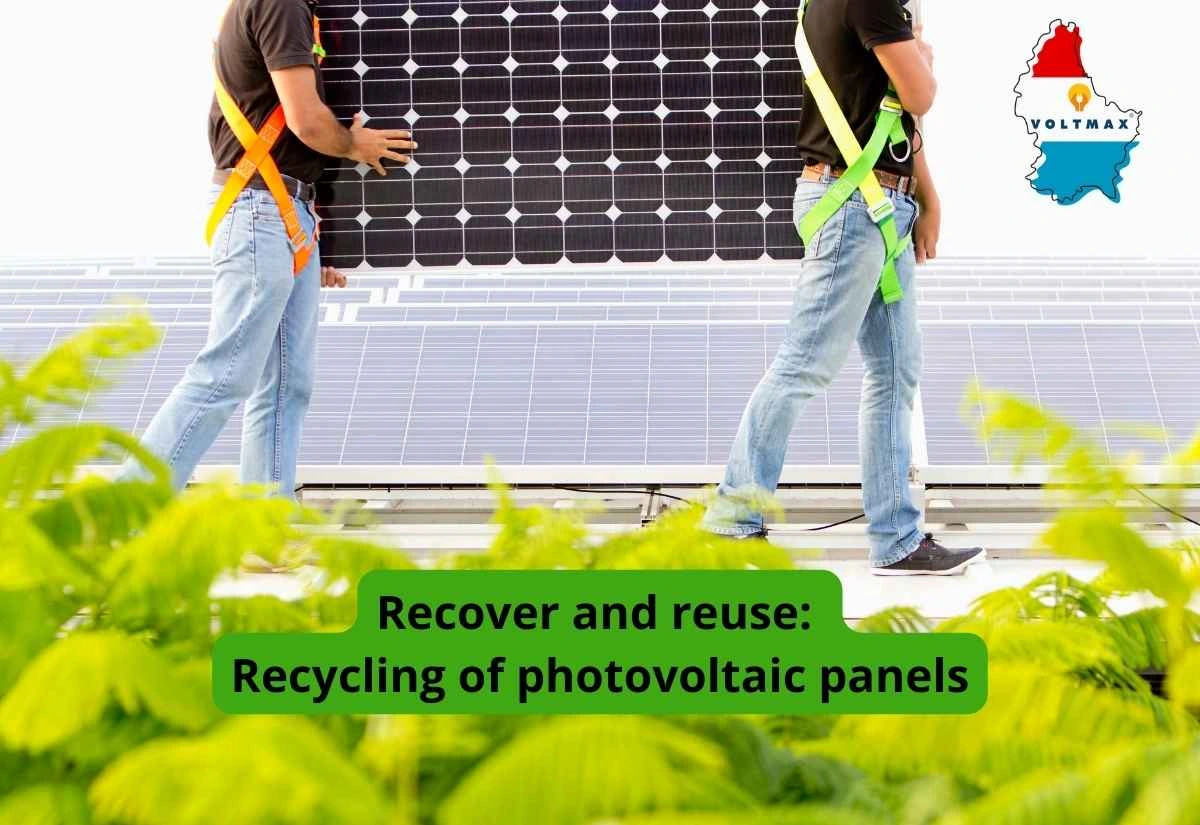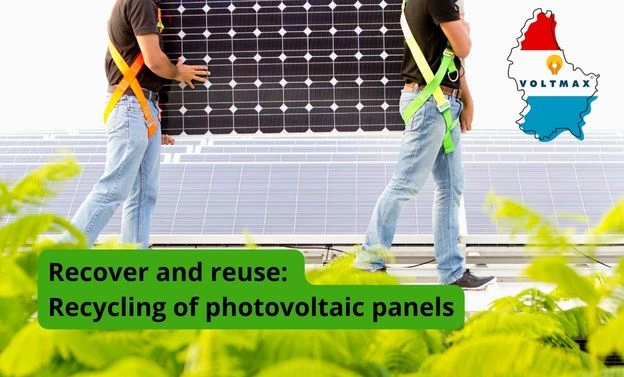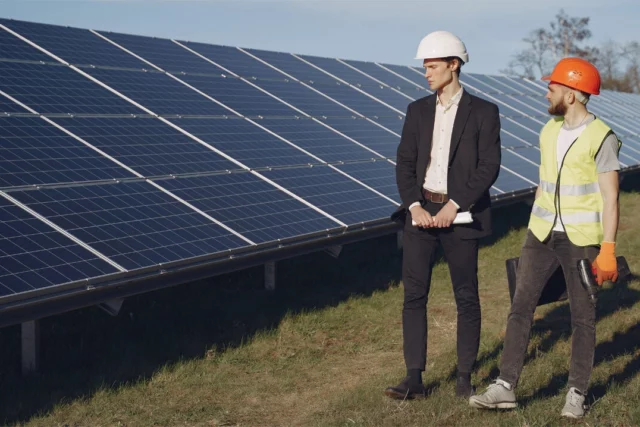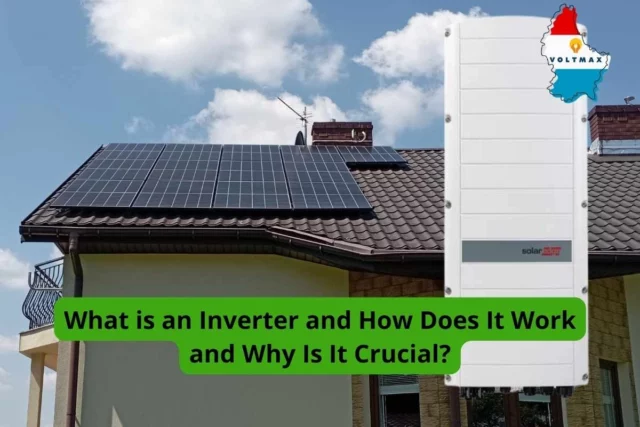
Table of contents
ToggleRecycling photovoltaic panels is an increasingly common phenomenon.
Recycling of photovoltaic panels in Europe and Luxembourg is gaining increasing importance in the context of the growing demand for sustainable energy solutions. This process, which enables the recovery of valuable materials and reduces environmental impact, becomes not only an answer to ecological needs but also to legal requirements imposed by EU directives.

Across Europe, thanks to stricter regulations on electronic waste and greater ecological awareness, countries such as Germany, Italy, Japan, and China lead in the implementation of advanced recycling technologies. The European Union, through various directives, obligates manufacturers and importers of photovoltaic panels to organize and finance recycling systems, aimed at increasing the efficiency of resource recovery and reducing the negative environmental impact.
Is it possible to recycle photovoltaic panels? If so, which part can be recycled?
In general, all photovoltaic panels are recyclable. Indeed, there are risk-free procedures for silicon-based panels as well as for thin-film panels containing cadmium. Moreover, recycling is regulated by the European Directive 2012/19/EU on waste electrical and electronic equipment, which is transposed into national law by the law of 9 June 2022 on waste electrical and electronic equipment: this framework currently requires at least 80% of the mass of a photovoltaic panel to be prepared for reuse or recycled, and 85% of the mass to be recovered.
The recycling rate of photovoltaic modules is nevertheless close to 100%, considering that the modules are generally composed mainly of glass, aluminium and other metals. Net modules usually contain very limited amounts of synthetic materials, such as silicon or other minerals. However, it is technically possible to recycle these elements, even if the processes for extracting them are not yet cost-effective. Thus, these materials are currently mainly used for thermal recovery.
The photovoltaic panel recycling process, which includes collecting and sorting, dismantling, shredding, thermal treatments, chemical processes, and cleaning, allows for the recovery of key materials such as glass, metals (including silver and aluminum), silicon, and other substances. These actions not only contribute to environmental protection but also support the development of sustainable solar energy, offering a second life to recovered materials. Let’s trace the key stages of this process that enable the transformation of used photovoltaic panels into valuable resources.
Stages of the recycling process
The photovoltaic panel recycling process consists of several stages:
- Collecting and sorting: Panels are collected and transported to recycling centers, where they are sorted based on their type and material composition. The initial segregation involves separating elements into major categories: panels, equipment, wiring, heat sources, etc.
- Dismantling: The preliminary dismantling involves removing aluminum frames and connectors, which are relatively easy to recover and reuse.
- Shredding: Next, the panels are shredded to reduce their size and facilitate the separation of different components.
- Thermal treatments: In some methods, panels are subjected to high temperatures to separate glass from other materials.
- Chemical processes: At this stage, various chemical methods are used to recover valuable materials, such as silver, lead, or silicon.
- Cleaning: The final stage involves cleaning the recovered materials so they are ready for reuse in the production of new photovoltaic panels or other products. Recovered substances and materials
In the process of recycling photovoltaic panels, a range of valuable materials are recovered:
- Glass: Makes up about 75% of the panel’s mass and is easily recovered for reuse. The possibility of recovering glass from photovoltaic panels is high, reaching about 90-95%. This glass can be reused in the production of new panels or other products.
- Metals, such as silver used in wires, and aluminum from panel frames. The recovery of metals from photovoltaic panels is also efficient, with the recovery of silver reaching up to 95%, and aluminum – up to 100%. These metals can be reused in various industrial sectors.
- Silicon: Can be recovered, although its purification for reuse in photovoltaic panels is more complicated. The recovery of silicon is more complex, but recycling technologies continue to develop, aiming to increase recovery efficiency. Currently, about 85% of silicon can be recovered, which after proper cleaning can be reused in the production of new photovoltaic panels.
- Other materials, including copper, lead, and plastics, are also recovered, though their percentage share in the panel mass is smaller.
Do photovoltaic panels contain hazardous materials?
With regard to cells made of silicon, which are by far the most widely used on the Luxembourg market, current production techniques do not require the use of any substances that are harmful to the environment.
Thin-film cells use elements such as cadmium or tellurium. The quantities used for the production of related modules are, however, minimal, especially for cells composed of cadmium telluride, known as CdTe. CdTe has low toxicity and the environmental consequences are considered negligible compared to the impact that could be caused by other means of electricity generation.
What is the environmental impact of photovoltaic panels?
The environmental impact is taken into account over the entire life cycle. Thus, environmental effects (such as the impact on climate change, the extraction of minerals, toxicity for human beings, etc.) are taken into consideration during the production and operation of the photovoltaic installation, including the savings made due to the energy produced during its life cycle.
Even if we consider that the production of certain photovoltaic panels requires scarce resources and hazardous materials, the environmental impact throughout their life cycle is less than that caused by the national or European electricity mix. This overall impact can be further reduced by recycling end-of-life panels or by refurbishing used panels for reuse in a second life.
Recycling law of photovoltaic panels in Luxembourg
In Luxembourg according to the law of 9 June 2022 on waste electrical and electronic equipment, the producer is responsible for the collection and processing of photovoltaic panels.
Producer means any natural person or legal entity who manufactures photovoltaic panels in Luxembourg or initially imports them onto the Luxembourg market. Any person established in another Member State or in a third country who, on a professional basis, supplies photovoltaic panels directly to a user in Luxembourg is considered a producer. In practice, in the majority of cases, this is the installer of the photovoltaic plant in Luxembourg.
Possibilities for owners to dispose of their old photovoltaic panels
For photovoltaic panels put on the market before 13/08/2005 :
- in case of replacement of the photovoltaic panels, the take back of the old panel is free of charge and must be ensured by the company supplying the new equipment
- in case of dismantling of the photovoltaic panel (non-replacement of the panel), the removal by a professional collector is done against payment by the user
For photovoltaic panels placed on the market after 13/08/2005 :
- free take-back by the producer who bears the costs of collection and recovery of the photovoltaic panels.
In summary
In summary, the development of photovoltaic panel recycling technologies in Europe and Luxembourg is a key element of the sustainable development strategy, allowing for the recovery of valuable materials, waste reduction, and decreasing the negative environmental impact. Thanks to engagement at the national and EU levels, prospects for the efficient recycling of photovoltaic panels appear promising, significantly impacting the future of solar energy.







